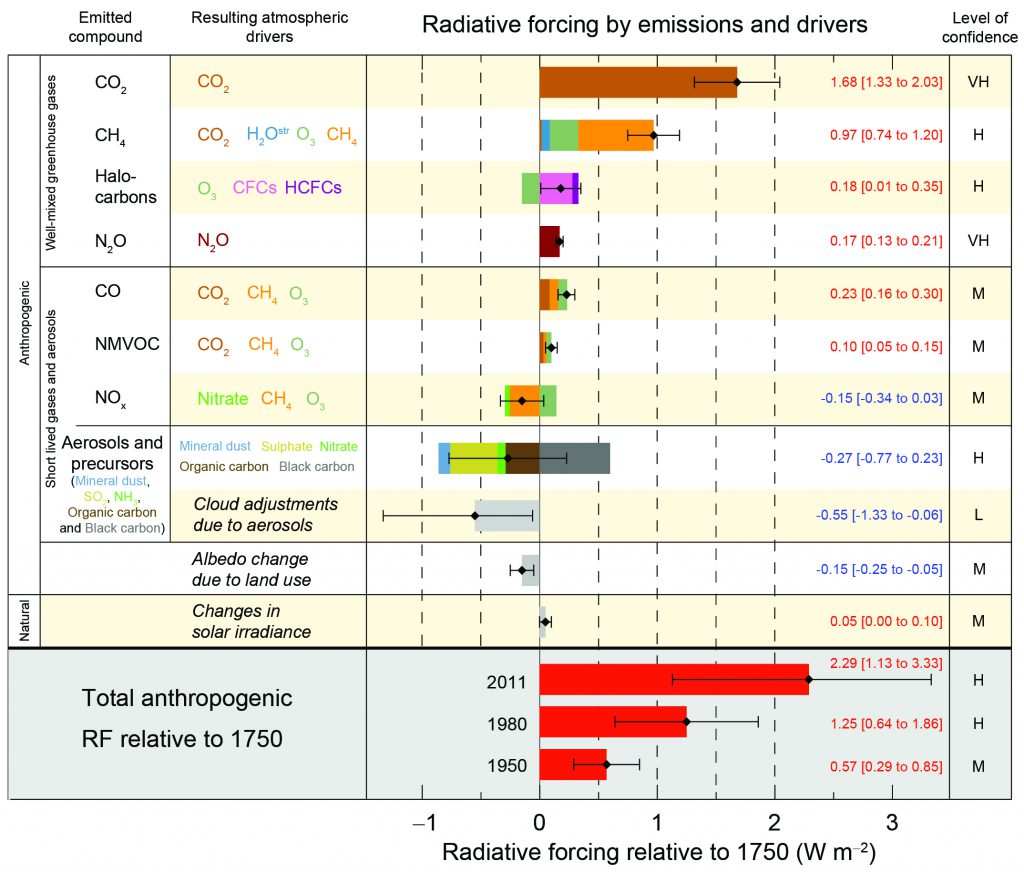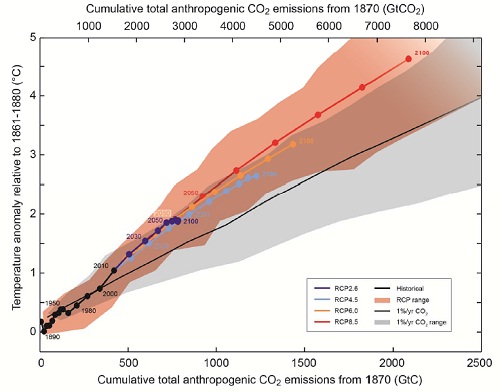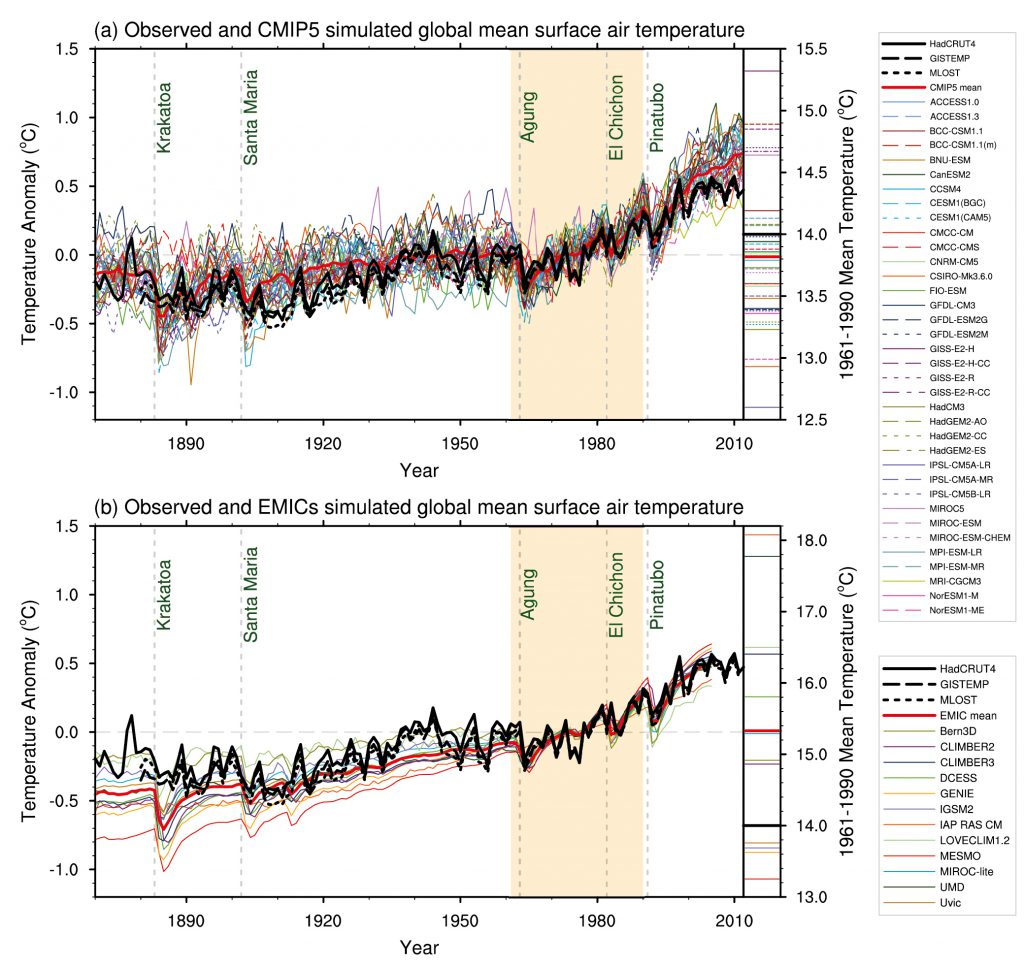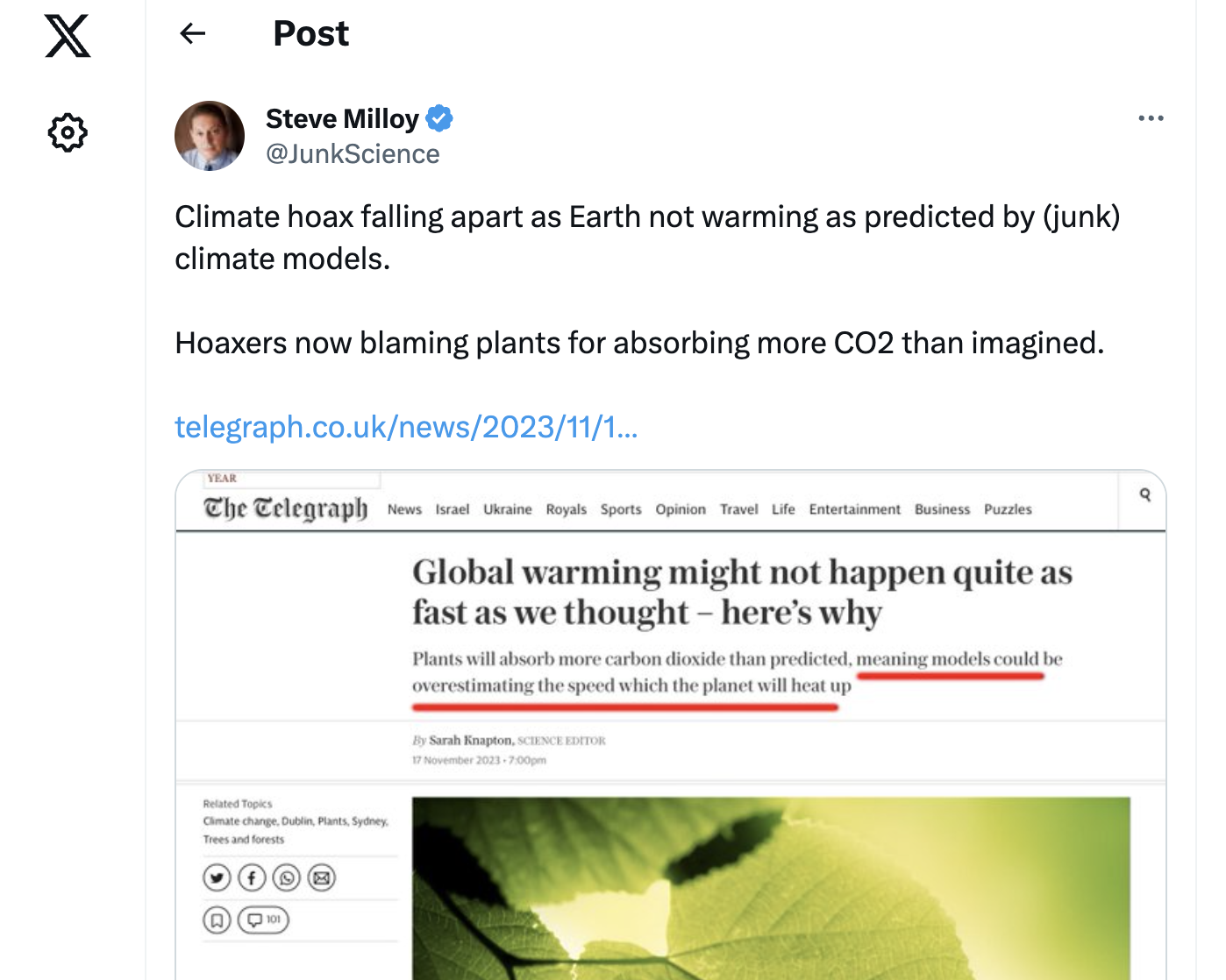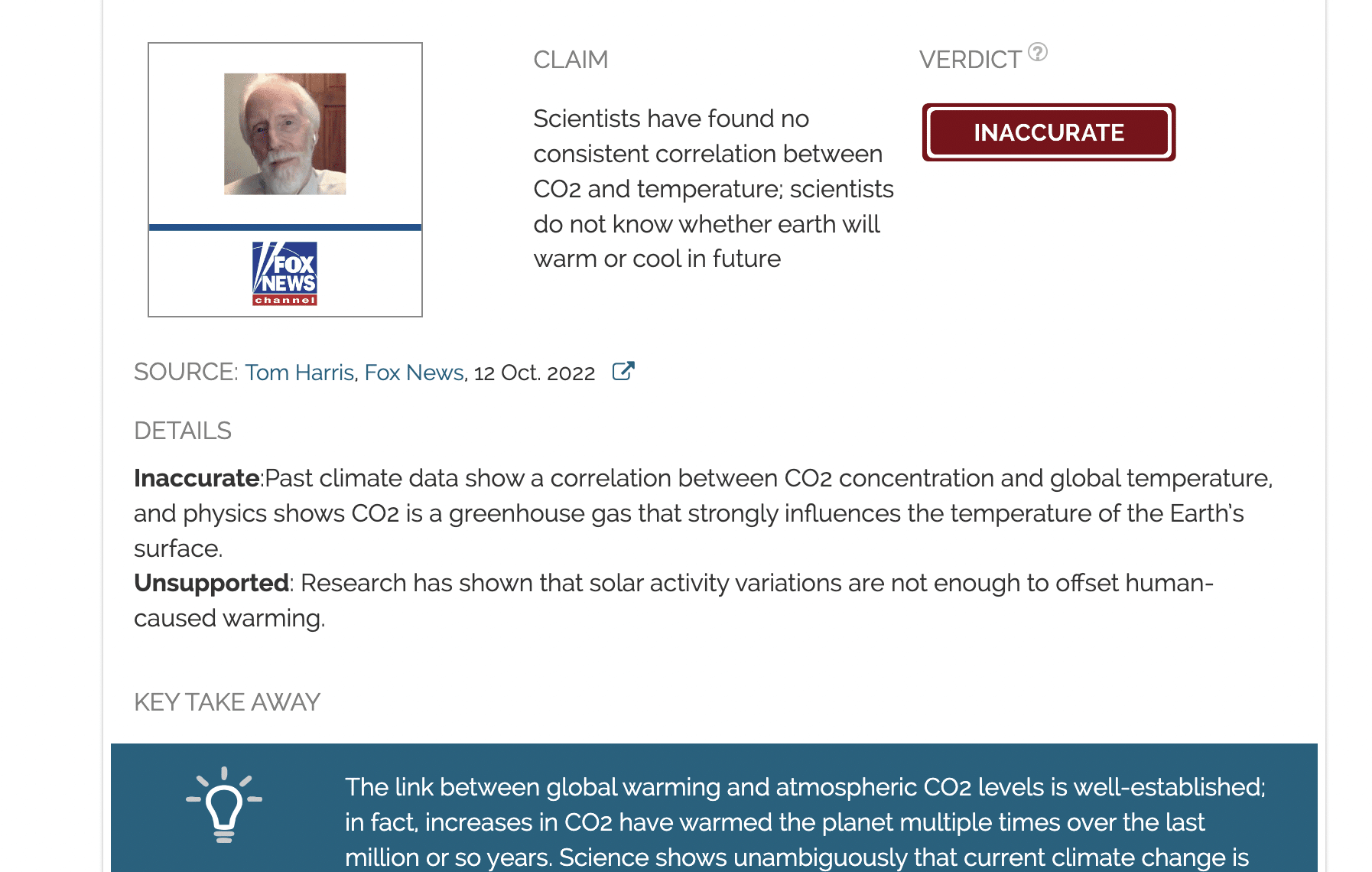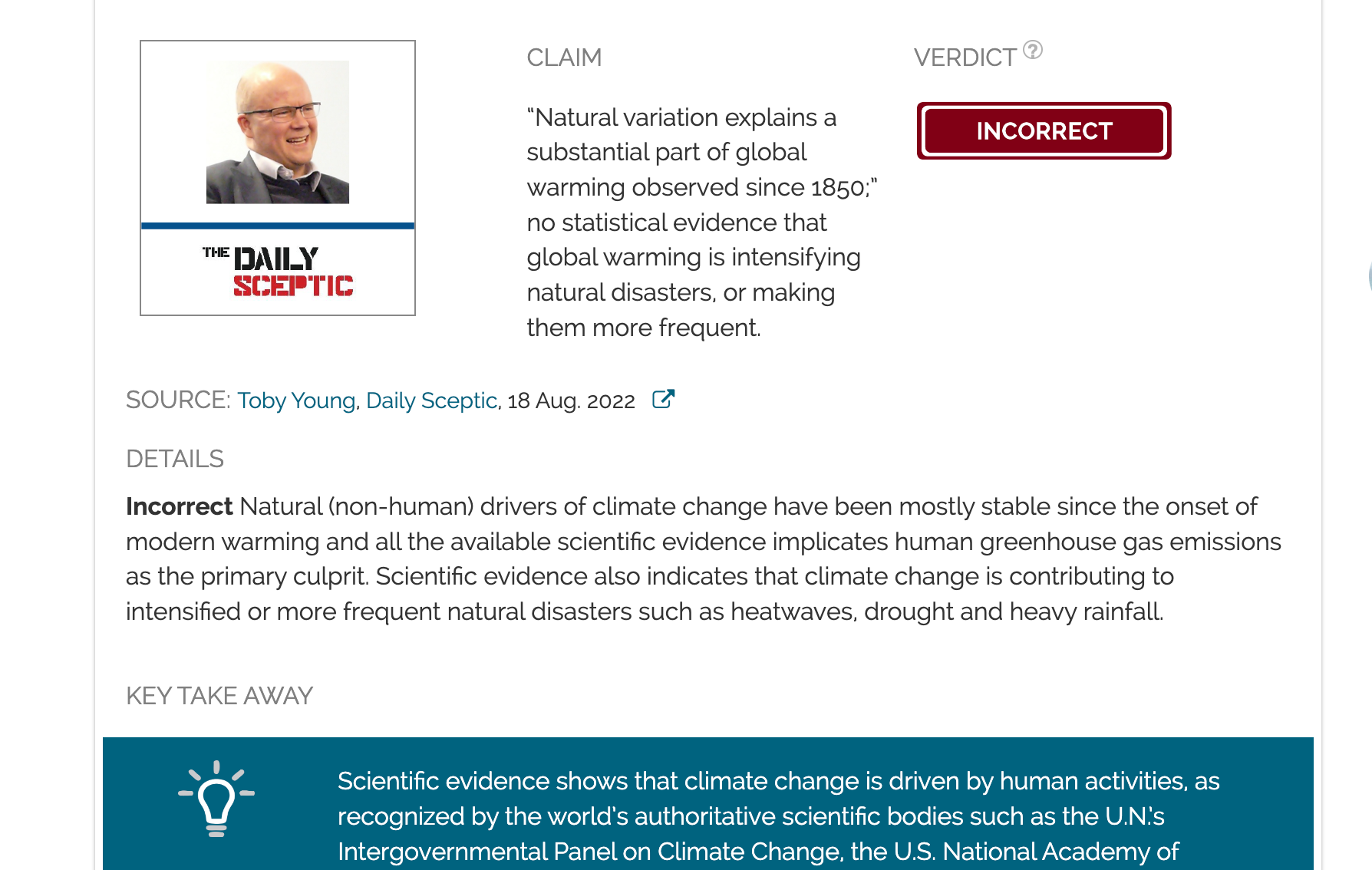- Climate
Analysis of "Why are climate-change models so flawed? Because climate science is so incomplete"
Reviewed content
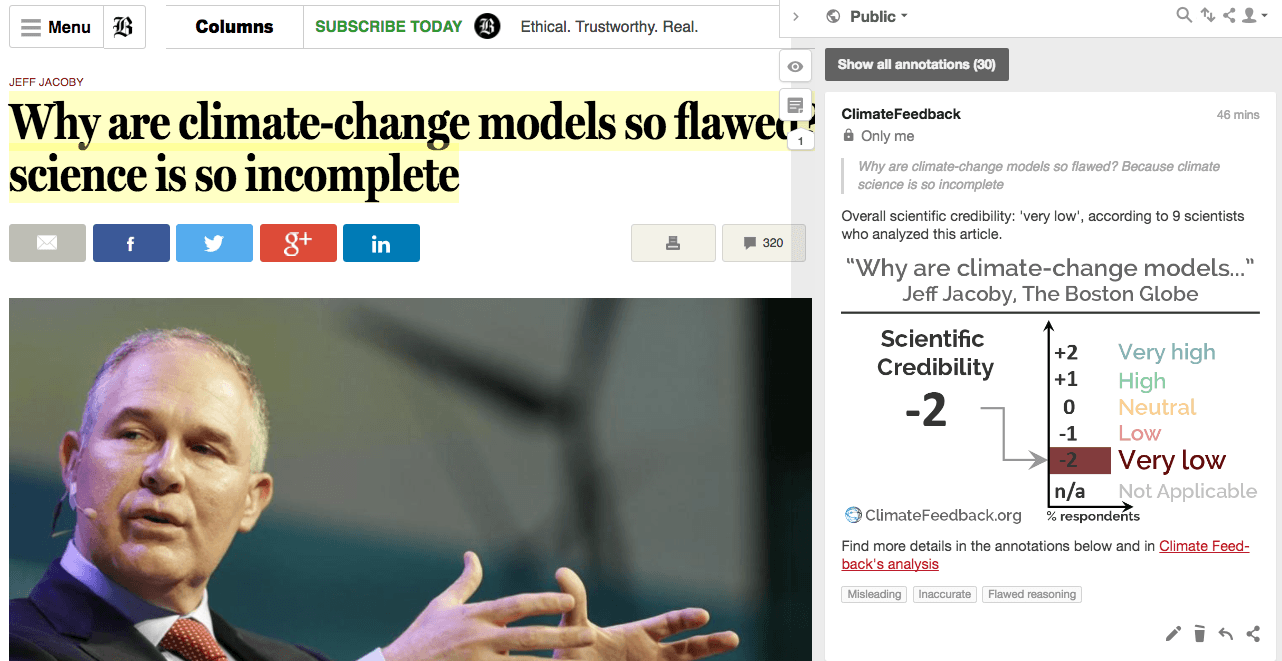
Published in The Boston Globe, by Jeff Jacoby, on 2017-03-14.
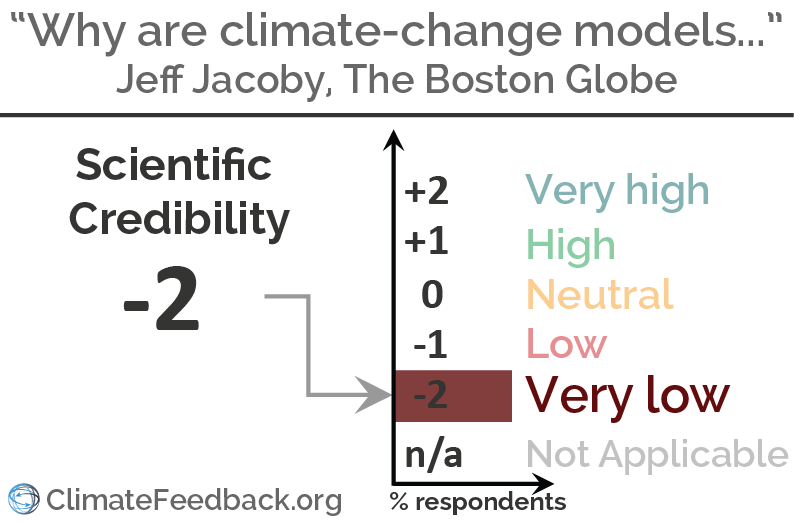
Scientists’ Feedback
SUMMARY
An article by Boston Globe columnist Jeff Jacoby argues that climate science is too “incomplete” to determine whether human-caused emissions of greenhouse gases like carbon dioxide could be responsible for global warming. The column defended US EPA Administrator Scott Pruitt’s recent statement that he “would not agree that [human activity is] a primary contributor to the global warming that we see”—a statement scientists reviewed and found to be incorrect.
Scientists who analyzed Jacoby’s column found that it is inaccurate, misleading, and uses flawed reasoning to support its central claims. In reality, CO2’s role in the climate system is well understood, and this fundamental knowledge informs the determinations that humans are responsible for modern climate change, and that continued greenhouse gas emissions will cause further warming.
See all the scientists’ annotations in context
REVIEWERS’ OVERALL FEEDBACK
These comments are the overall opinion of scientists on the article, they are substantiated by their knowledge in the field and by the content of the analysis in the annotations on the article.

Associate Professor, University of Exeter
This is a highly inaccurate article that makes a number of false and intentionally misleading claims. The weight of scientific evidence (summarised in the IPCC reports) shows that greenhouse gas emissions are the dominant cause of observed global warming. The claim that climate models “always predict far more warming” is demonstrably false. The discussion of complexity is intended to mislead: the fact that the climate system is incredibly complex does not mean we don’t understand key aspects of how it functions.

Professor, Sr. Research, Oregon State University
Jacoby used a flurry of words to claim that models did not work. He set up a straw man about complexity that was irrelevant and never actually examined real climate models.

Assistant Professor, Purdue University
The article is full of logical fallacies: just because a system has many moving parts does not mean it is unpredictable.
Postdoctoral researcher, Hamburg University, Meteorologisches Institut
The facts given by the author regarding the skills of climate models and the state of the art are mostly wrong. The most important processes are not understood by the author and his logic is flawed
This article combines tired and regularly-debunked climate myths with faulty reasoning to support a statement which is ungrounded in scientific reality.

Professor, Victoria University of Wellington
One of the most egregious pieces of misinformation I have seen in the media in years.

Climate Scientist, Environmental Defense Fund
This article employs flawed reasoning mixed with inaccurate statements to create a false impression of climate scientists’ state of understanding.
Associate Professor, Oregon State University
The article contains major scientific inaccuracies and it omits important information.
Notes:
[1] See the rating guidelines used for article evaluations.
[2] Each evaluation is independent. Scientists’ comments are all published at the same time.
Key Take-aways
The statements quoted below are from the article; comments and replies are from the reviewers.
“CO2 is certainly a heat-trapping greenhouse gas, but hardly the primary one: Water vapor accounts for about 95 percent of greenhouse gases. By contrast, carbon dioxide is only a trace component in the atmosphere: about 400 ppm (parts per million), or 0.04 percent.”

Research Scientist, SciSpace LLC, NASA Goddard Institute for Space Studies
First, it is true that water vapor constitutes the bulk of Earth’s present-day greenhouse effect (measured in terms of infrared absorption). Quantitatively, however, Jacoby is off by quite a bit. In fact, water vapor constitutes ~50% of the terrestrial greenhouse effect, not 95% (see here*). Clouds (solid and liquid water that form when the vapor condenses) constitute another ~25%, but CO2 contributes to almost all of the remaining fraction (only ~5% or so from all of the other combined gases). This is because CO2 still absorbs well in spectral regions where water vapor doesn’t, and also because the upper troposphere is very dry; the ability to absorb intense surface emission and re-emit it at colder, higher layers of the atmosphere is critical for the maintenance of a planetary greenhouse effect.
Secondly, the water vapor greenhouse effect is not independent of the CO2 in the atmosphere.
Jacoby stresses that CO2 is only a trace component of the atmosphere, an argument that is irritatingly unoriginal and provides useless context when describing the flow of radiation through the atmosphere. As before, CO2 accounts for ~20% of Earth’s greenhouse effect. N2 and O2 account for nearly all of Earth’s atmospheric mass. However, if the atmosphere were purely N2 and O2, the planet would likely be in a snowball state due to the lack of greenhouse trapping. This is where the equations of radiative transfer must be applied, rather than a naive intuition about proportions.
- Schmidt et al (2010) Attribution of the present-day total greenhouse effect, Journal of Geophysical Research: Atmospheres.

Research Scientist, Lawrence Livermore National Laboratory
Another helpful quote comes from this article:
“The contribution of CO2 to the greenhouse effect, considerable though it is, understates the central role of the gas as a controller of climate. The atmosphere, if CO2 were removed from it, would cool enough that much of the water vapor would rain out. That precipitation, in turn, would cause further cooling and ultimately spiral Earth into a globally glaciated snowball state. It is only the present of CO2 that keeps Earth’s atmosphere warm enough to contain much water vapor.”
I like to think of CO2 as analogous to a military commander and water vapor as analogous to an army of foot soldiers. Even though the water vapor foot soldiers do most of the fighting, the CO2 commander sends the army to battle.
While it is true that carbon dioxide constitutes about 400 ppm (or 0.04%) of the atmosphere, the implication that this means it is insignificant in Earth’s climate is incorrect. It is the ability of a gas to absorb radiation, and so affect energy balance of the Earth, not its concentration, which is important. This effect on Earth’s energy balance can be quantified by the radiative forcing (RF); a positive RF means a surface warming effect and a negative RF a cooling. The figure below, from the 2013 IPCC report shows estimates of RF for a range of factors which have influenced climate from 1750-2011. As can be seen, increasing carbon dioxide concentrations have the largest RF and therefore the largest impact on climate.
I also stress that knowledge of the important role of carbon dioxide (despite its low concentration) in Earth’s climate is not new, and dates back to the work of Tyndall, Arrhenius, and others in the 19th century.
“Moreover, its warming impact decreases sharply after the first 20 or 30 ppm. Adding more CO2 molecules to the atmosphere is like painting over a red wall with white paint — the first coat does most of the work of concealing the red. A second coat of paint has much less of an effect, while adding a third or fourth coat has almost no impact at all.”

Research Scientist, SciSpace LLC, NASA Goddard Institute for Space Studies
Jacoby emphasizes the logarithmic nature of how CO2 affects the energy balance of Earth, and hence surface temperature (i.e., going from 10 ppm of CO2 to 11 ppm would have a much larger impact than going from 300 to 301 ppm). This is correct, but has been known for well over half a century now, and is fully accounted for in even simple estimates of future warming. This is therefore a distraction.

Associate Professor, Oregon State University
The effects of CO2 do not decrease sharply after the first 20 or 30 ppm. The radiative effects of CO2 are logarithmic, so they increase slightly less the higher CO2 gets but they don’t decrease sharply.

Climate Scientist, Environmental Defense Fund
This is flawed reasoning as it is not a sensible analogy for how the greenhouse effect works. The science is more complex:
Namely, radiation from the surface at a warmer temperature is absorbed in the layers above which are at a colder temperature; the colder layers emit less radiation so that there is a net loss of radiative energy escaping to space from the atmosphere-surface system as a whole, but coming about due to the “exchange” as formulated. This is true in absorption bands that are transparent and not opaque—i.e., in bands that are not saturated. In bands that are opaque, the radiation emanating from the layer to space represents a “cooling-to-space” and this too represents a “trapping”. In this regard, the lapse-rate and decrease of temperature with height (in the troposphere) are important. The more CO2 that is added to the atmosphere, the more heat that is “trapped” in the climate system, although it is not 1:1 and is instead a logarithmic relationship. However, regardless of the rate, we still have more warming with more CO2—that is unequivocally true.
Jacoby links to a blog page which explains the logarithmic relationship of CO2 concentrations and radiative forcing. Contrary to Jacoby’s implication, this is actually a well accepted part of climate science. For instance, see Myhre et al 1998* (table 3), who give detailed estimates of this logarithmic relationship.
However, as CO2 concentrations rise, the fraction of CO2 which remains in the atmosphere (rather than being absorbed by the ocean) is projected to increase (see Jones et al 2013*). The net effect is that the relationship between total CO2 emissions and surface temperature is almost linear. See the figure below from the 2013 IPCC report.
- Myhre et al (1998) New estimates of radiative forcing due to well mixed greenhouse gases, Geophysical Research Letters
- Jones et al (2013) Twenty-First-Century Compatible CO2 Emissions and Airborne Fraction Simulated by CMIP5 Earth System Models under Four Representative Concentration Pathways,
Journal of Climate
“There is a popular theory that atmospheric CO2 amplifies the creation of water vapor, thereby increasing warming through a ‘positive feedback loop.’ But that theory so far is mostly speculative; climate projections using models based on it have consistently failed, nearly always predicting far more warming than has occurred”

Senior Research Scientist, Canadian Centre for Climate Modelling and Analysis
[John Fyfe was the first author of the paper linked by Jacoby to support this claim]
The statement “climate projections using models based on it have consistently failed, nearly always predicting far more warming than has occurred” is false.
Climate models reproduced the observed record of global average temperature rise since the middle of the 20th Century. It is true that climate models overestimated the observed rate of warming over the early-21st Century but this was not unexpected. Over this period, and due to a well-known natural fluctuation in the climate system, temperatures over much of the tropical Pacific were cooler than normal. These ocean temperatures have warmed significantly over the past few years. Climate models represent these natural fluctuations in the climate system but do not – by design – reproduce the observed timing except by chance. This is the primary reason why climate models overestimated the rate of global average temperature rise over the early-21st Century.

Research Scientist, SciSpace LLC, NASA Goddard Institute for Space Studies
Jacoby discusses the so-called water vapor feedback, in which warming caused by CO2 (or anything) results in more water vapor in the atmosphere, increasing heating. However, his discussion is confused.
First, models are not based on a water vapor feedback. Such a feedback is result, not an assumption. There is no FORTRAN code written that tells a model to increase the water vapor concentration when the CO2 is going up. However, there is incredibly well-established thermodynamics assuring us that a warmer atmosphere can theoretically hold more water vapor.
This doesn’t mean it will—after all, deserts are very hot, but not very moist. This is because atmospheric dynamics (especially the rising and sinking motions of air) keep most of Earth’s atmosphere beneath its maximum vapor holding capacity. However, it turns out that observations and complex models (as well as more simple theoretical work) suggest that this degree of “subsaturation” (or relative humidity) doesn’t change much, so the actual water vapor concentration still goes up in a similar way that it would if it just behaved like a simple thermodynamic equation (see e.g., here and here and here)*. Indeed, this has been a robust result going back to at least the 1960s in observational and model-based syntheses of the problem, and is now very well understood.
Indeed, CO2 is the fundamental control knob on Earth’s climate over relatively long timescales, since the water vapor concentration is shackled to temperature in a very fundamental way, because the Sun’s output does not change very much except on geologic time intervals, and because CO2 is the principle non-condensing greenhouse gas capable of changing in response to geologic (or anthropogenic) sources and sinks on climate timescales.
- Pierrehumbert et al (2007) On the relative humidity of the Earth’s atmosphere, The General Circulation
- Held and Soden (2000) Water vapor feedback and global warming, Annual Review of Energy and the Environment
- Chung et al (2014) Upper-tropospheric moistening in response to anthropogenic warming, PNAS

Associate Professor, Oregon State University
The water vapor feedback, which is referred to here as “creation of water vapor” but in fact is higher water vapor in a warmer atmosphere, is a basic prediction of thermodynamics, one of the most well-tested branches of physics. Water vapor has been observed to increase*. So, there is nothing speculative about it.
The claim that climate models have consistently failed is false. In fact, the contrary is true. Climate model projections from the 1980s have essentially come true. For a recent example see Stouffer and Manabe (2017)*.
- Chung et al (2014) Upper-tropospheric moistening in response to anthropogenic warming, PNAS
- Stouffer and Manabe (2017) Assessing temperature pattern projections made in 1989, Nature Climate Change

Research Scientist, Lawrence Livermore National Laboratory
All available evidence suggests that the atmosphere maintains nearly constant relative humidity, meaning that the absolute concentration of water vapor increases exponentially with temperature. The exponential increase is grounded in fundamental physics known as the Clausius-Clapeyron equation.
A particularly clever test of the amplifying water vapor feedback was conducted in response to the Mount Pinatubo eruption in 1991*. If there were no amplifying water vapor feedback, then the global cooling in response to the volcanic eruption would have been much smaller than observed.
- Soden et al (2002) Global Cooling After the Eruption of Mount Pinatubo: A Test of Climate Feedback by Water Vapor, Science
“The science is far from settled.”

Professor, Victoria University of Wellington
The basic controls on the climate, sunlight and greenhouse gases, have been understood for over a century and are not disputed. The frontiers of climate research are where the debates lie, as with any branch of science.
“[Pruitt’s statement] was an accurate and judicious answer”

Climate Scientist, Environmental Defense Fund
It is objectively not an accurate answer and is misleading at best. [Pruitt’s statement has been reviewed by scientists with Climate Feedback and found to be incorrect.]
While it is certainly challenging to determine human influence on the climate, decades of research by tens of thousands of scientists from different institutions all over the world have yielded a nearly unanimous consensus with extreme confidence that humans are the dominant cause of climate change. In fact, scientists have been questioning and researching human influence on the climate for nearly 200 years. Further, we can use techniques similar to the smoking-cancer causality research to prove that humans are mainly responsible and to show that carbon dioxide is the primary control knob for today’s climate change. There is no “tremendous disagreement” or “debate” about this.
“Earth’s climate system is unfathomably complex. […] The more variables there are in any system or train of events, the lower the probability of all of them coming to pass. Your odds of correctly guessing the outcome of a flipped coin are 1 in 2, but your odds of guessing correctly twice in a row are only 1 in 4 — i.e., ½ x ½ Extending your winning streak to a third guess is even less probable: just 1 in 8.”

Professor, Victoria University of Wellington
Yes, it is complex, but not unfathomable. The basics are simple—the energy budget at Earth’s surface is controlled by the intensity of sunlight reaching the ground and the amount of greenhouse gas in the atmosphere. That’s it.
This analogy implies everything is happening randomly in the climate system. This is not the case. There is a great deal of structure imposed by the laws of fluid motion and energy transfer, and by the basic geometry and rotation rate of the Earth.
Postdoctoral researcher, Hamburg University, Meteorologisches Institut
The Earth system is indeed complex with nonlinear interactions between various components on a large range of time and spatial scales. However, some processes are very robust, such as the response of the global energy budget to increased greenhouse gases, so that the surface of the Earth eventually has to warm up in order to reach a radiative balance. The distribution of the heating, the rate of melting of the ice sheets, the changes in the occurrence of extremes, etc. are more difficult to predict and that is why we need state-of-the art global climate models. Last, one should not confuse the weather prediction of an exact meteorological state, limited by the chaotic nature of the system, and climate projections of the statistics of variables in response to forcing, such as the global mean surface temperature sensitivity to greenhouse gases emissions.
“The list of variables that shape climate […] would run to hundreds, if not thousands, of elements, none of which scientists would claim to understand with absolute precision.”

Professor, Sr. Research, Oregon State University
Jacoby is making a laundry list, not trying to understand the issues. He is also confusing the issue by trying to claim that since scientists cannot predict climate change at a given small location at a fixed point in future time that they do not have the ability to generally predict the the future trend. Climate scientists are after the trend.
Most of the variables he mentions cause the local climate to deviate to a small extent from the trend. Some, like volcanic activity or El Niño, affect the climate for a small number of years, and then their effect disappears.

Research Scientist, SciSpace LLC, NASA Goddard Institute for Space Studies
The basic argument in the remainder of the article is one of “complexity” and the notion that climatologists cannot perfectly understand thousands of variables, and hence the behavior of the system under investigation.
Jacoby is not completely wrong—climate is extremely complex, and poses no shortage of interesting research questions.
However, it is sometimes difficult for non-specialists to appreciate the emergent simplicity that can arise in an incredibly complex system. After all, how do we know summer will be warmer than winter, that the top of Mt. Everest is colder than the base, or that Arizona is expected to be on average drier than Florida, or that the equator ought to be hotter than New York, or that the climate will cool following a large volcanic eruption?
These statements are not just based on prior observations, but in fact can be predicted by applying fundamental equations to a rotating planet. Part of the beauty in studying atmospheric science is in gaining an appreciation for where complexity is counterbalanced by an almost eerie predictability, much like how the outcome of a single spin in roulette is hopelessly unpredictable (and certainly influenced by every slight detail at the time the dealer releases the ball), but casinos have no problem with such complexity because the statistical behavior of the roulette wheel is well-posed. Similarly, the statistical behavior of the atmosphere, while unsolved, is not actually that complex.
The appeal to complexity is a compelling one. Nonetheless, progress has been made in many complex sciences (astrophysics, geology) in which the system under investigation cannot be experimentally isolated, and yet where so much is known.
However, it turns out to be incredibly simple to rule out El Niño, volcanic eruptions, soil quality, sunspot cycles, plate tectonics, etc. to the trend in global temperatures since 1950. Just as geologists can inform you of the glacial history of a region, sometimes with little more than a trained eye, CO2 leaves behind “fingerprints” in the atmospheric warming that other “forcing agents” do not.
Another perhaps surprising component is that this result is not extremely sensitive to unknown variables. Suppose, for example, that the Andes Mountains were abruptly flattened. This would almost certainly affect important aspects of the global and regional climate, but many of the critical phenomena of the climate system (e.g. that the equator is wet where air rises, that storm tracks develop in the mid-latitudes, the presence of a jet stream, etc.) would still remain. Furthermore, adding CO2 to a “flat-Andes hypothetical Earth” would still result in warming. It’s physics, and it’s unavoidable.
It is true that the exact magnitude of future warming, even if we knew future carbon emissions perfectly, is still not known to within even 10%. However, that uncertainty range does not overlap with “very little warming” or “make the planet uninhabitable warming.” In any case, if one’s argument is based on how complex the system is, surely perturbing that complex system is not something they ought to advocate for!
“What are the odds that a climate model built on a system that simple would be reliable? Less than 50/50. (Multiplying .95 by itself 15 times yields 46.3 percent.)”

Professor, Victoria University of Wellington
Again, this assumes that all variables are independent and everything is happening randomly. This is just not the case. Winds, temperatures, pressures, cloud formation, and so on are all bound together in coherent ways by the laws of physics.
Postdoctoral researcher, Hamburg University, Meteorologisches Institut
This is absolutely not how prediction skills are and should be measured. Assuming that each variable is given the same weight, the initial error would be of 5%. How this error grows with the prediction is a nontrivial problem, which cannot be explained by kindergarten probabilities, but requires observations, theory and modeling. Moreover, the problem of the predictability of fast weather fluctuations become irrelevant for long-term climate projections of statistics in response to forcing.
“Is it any surprise that climate-change predictions in the real world — where the complexities are exponentially greater and the exactitude of knowledge much less — have such a poor track record?”
One way we can evaluate climate models is their ability to simulate past observed climate changes. The following figure from the 2013 IPCC report shows that they in fact have a good track record in capturing climate change over past century.

